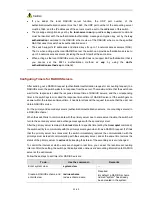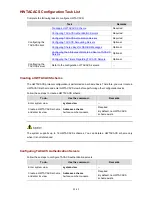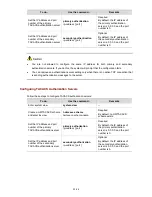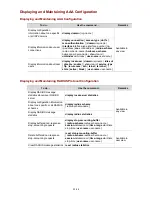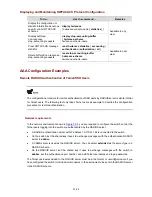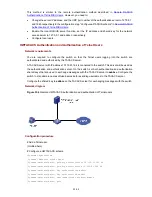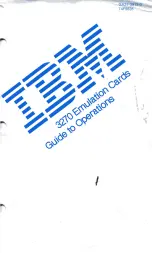
33-18
To do…
Use the command…
Remarks
Set the status of the secondary
RADIUS
authentication/authorization
server
state
secondary
authentication
{
block
|
active
}
Set the status of the secondary
RADIUS accounting server
state
secondary accounting
{
block
|
active
}
Configuring the Attributes of Data to be Sent to RADIUS Servers
Follow these steps to configure the attributes of data to be sent to RADIUS servers:
To do…
Use the command…
Remarks
Enter system view
system-view
—
Create a RADIUS scheme and
enter its view
radius scheme
radius-scheme-name
Required
By default, a RADIUS scheme
named "system" has already
been created in the system.
Set the format of the
usernames to be sent to
RADIUS server
user-name-format
{
with-domain
|
without-domain
}
Optional
By default, the usernames sent
from the switch to RADIUS
server carry ISP domain
names.
Set the units of data flows to
RADIUS servers
data-flow-format data
{
byte
|
giga-byte
|
kilo-byte
|
mega-byte
}
packet
{
giga-packet
|
kilo-packet
|
mega- packet
|
one-packet
}
Optional
By default, in a RADIUS
scheme, the data unit and
packet unit for outgoing
RADIUS flows are byte and
one-packet respectively.
Set the MAC address format of
the Calling-Station-Id (Type 31)
field in RADIUS packets
calling-station-id mode
{
mode1 | mode2
}
{
lowercase | uppercase
}
Optional
By default, the MAC address
format is XXXX-XXXX-XXXX,
in lowercase.
RADIUS scheme view
nas-ip ip-address
Set the source IP address of
outgoing RADIUS messages
System view
radius nas-ip ip-address
Optional
By default, no source IP
address is set; and the IP
address of the corresponding
outbound interface is used as
the source IP address.

















